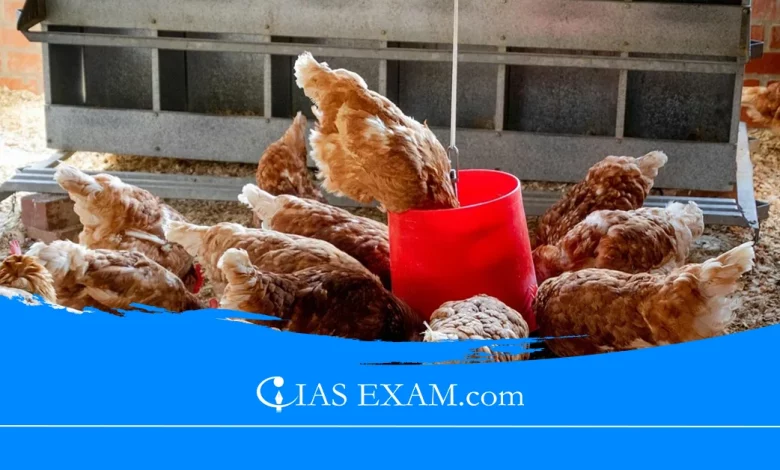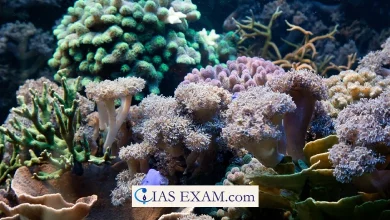India’s First AMR Surveillance Report in Fisheries, Livestock by FAO
Syllabus: Economic[GS Paper-3]

Context
The FAO and ICAR have released the first-ever analysis of antimicrobial resistance trends in India’s fisheries and livestock industries. The report includes data from the INFAAR surveillance network for the years 2019-22.
AMR Surveillance in India’s Fisheries Sector
- A surveillance study involving samples from three aquaculture systems in India over the past 12 years found that 6789 bacteria isolates were present, including Staphylococcus aureus and Pseudomonas aeruginosa.
- Staphylococcus aureus, particularly MRSA, is known for its resistance to antibiotics.
- The study found elevated amounts of antibiotics in various water systems, including rivers, lakes, and streams.
- The findings have identified resistance types for freshwater and marine bacteria, such as Aeromonas and Vibrio.
AMR Surveillance in India’s Livestock Sector
- The clinical study would be carried out through the motion of the bacteria in animals like cattle, buffalo, goats, sheep, pigs, and poultry.
- They processed a total of 5,983 samples with E. coli bacteria (2,076 of them) and Staphylococcus bacteria (1,244 of them) found in 1234 samples.
- The E.coli bacteria demonstrated resistance to cefotaxime and ampicillin, while both types of Staphylococcus bacteria showed the resistance to penicillin..
- PA antibiotic resistance was more typical in bacteria from poultry sources than it was in bacteria from other animal source food.
About AMR and INFAAR:
- AMR is one of the greatest challenges that the world is facing with humans, animals, and the environment being affected on the whole. The growing microbial resistance to antimicrobial agents such as such-as antibiotics is a slowing threat to public health and food security.
- INFAAR was founded owing to these challenges, which call into question their management and control. The objectives of this scheme are to keep a check on AMR in Indian fisheries and livestock.
Objectives of INFAAR
- Surveillance of AMR: The key element is to identify and evaluate the tendency of AMR as it is applied in the sphere of agriculture, especially in aquaculture and cattle production.
- Data Collection: Collecting statistics about AMR epidemiology through surveys in different geographic zones, along with sectors and in which fields is helpful.
- Policy and Decision Making: The information from the INFAAR project will be applied to informed policymaking and practical actions as a preemptive measure for the threat to combat AMR.
Challenges
- Data Collection and Standardization: The implementation of homogenous operating procedures and reliable data platform is a huge hassle for the fisheries and livestock sectors which are very diversified and extensive in nature.
- Capacity Building: The capacity strengthening must be going on to allow for operational improvement on surveillance activities, with manpower augmentation involving the need to bring other institutions on board.
- Implementation Hurdles: The French wide geographical and biological diversity of India presents quite a number of difficult problems for the uniform and continuous surveillance competency.
Achievements
- Establishment of a Surveillance Network: INFAAR has been able to integrate ICAR laboratories, thus making an increase in the surveillance network capacities on AMR.
- International Collaboration: Such help in technical and operational operations as FAO and USAID provide has been valued.
Responses and Strategies
- Network Expansion: In one of its great landmarks, INFAAR incorporated multiple labs under its system, elevating the network’s monitoring capacity.
- International Support: Through collaboration with global organisations technical and financial dispositions are brought into the game.
- Operational Mechanisms: Creating efficient ways for data storage, publishing of results and quality system empowerment are some of the key mechanisms.
Conclusion
Establishment of INFAAR is likely to form a solid ground in response to the AMR crisis in the Indian fisheries and livestock. Behind such a success, however, lies the question of how to implement it effectively, to get ongoing support, and to collaborate across relevant stakeholders. This initiative is therefore very valuable for animal well-being, as well as for making food safe and achieving public health goals, and also for degradation. It supports sustainable agriculture and conserves the environment.
Source: DTE
UPSC Mains Practice Question
Q.Evaluate the significance of India’s First AMR Surveillance Report in Fisheries and Livestock by the FAO in the context of sustainable agricultural practices and public health. Discuss the challenges involved in implementing AMR surveillance and suggest measures to enhance its effectiveness.





.png)



